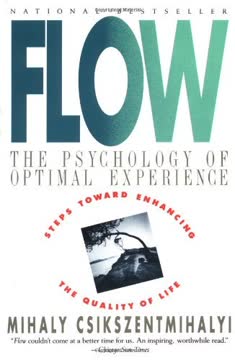Key Takeaways
1. Mental health exists on a spectrum, with most people in the mid-range
"The healthiest families showed all these variables to some extent. But … there were significant differences in the degree to which they were all found in each family."
Spectrum of health. Mental health is not a binary state of "healthy" or "unhealthy," but a continuous spectrum. At the lowest end, we find chaotic and disorganized behavior, while at the highest end, we see exceptional mental well-being. Most people, however, fall somewhere in the middle.
Mid-range characteristics:
- Degree of rigidity in thinking and behavior
- Limited ability to face and accept all aspects of reality
- Some difficulty in adapting to change
- Tendency to judge and criticize others
- Partial openness to new ideas and experiences
The mid-range is where most personal growth and societal change occur, as people in this range have the capacity for improvement while also facing common challenges that can be addressed through therapy, education, and societal reforms.
2. Exceptionally healthy individuals display an Affiliative Attitude
"These particularly healthy families are unusually positive in their attitude to life and other people. In general, they give the impression of enjoying themselves, enjoying each other, and especially of reaching out and being friendly to the people around them."
Openness and warmth. Exceptionally healthy individuals approach life and relationships with a genuine warmth and openness. This Affiliative Attitude is not a calculated strategy but a natural expression of their inner well-being and confidence.
Characteristics of the Affiliative Attitude:
- Genuine enjoyment of social interactions
- Ability to see the best in others
- Resilience in the face of initial rejection or unfriendliness
- Natural inclination to help and support others
- Capacity to bring out the best in those around them
This attitude creates a positive feedback loop, where their warmth elicits positive responses from others, further reinforcing their optimistic outlook and contributing to a more harmonious social environment.
3. Emotional independence balances intimacy and separateness
"It looks paradoxical at first, but really it's obvious that the more 'separateness' you put on one side of the scales, the more 'togetherness' you can put on the other side."
Healthy balance. Exceptionally healthy individuals maintain a delicate balance between emotional closeness and independence. This balance allows for deep, meaningful relationships without sacrificing personal autonomy or identity.
Key aspects of emotional independence:
- Ability to enjoy solitude without feeling lonely
- Capacity to maintain a sense of self within relationships
- Freedom to pursue individual interests and goals
- Resilience in the face of relationship challenges
- Ability to support partners' independence without feeling threatened
This balance enables individuals to form more secure and fulfilling relationships, as they can fully engage in intimacy without fear of losing themselves or becoming overly dependent on others.
4. Clear parental authority with full child consultation fosters healthy families
"The children are always consulted very fully – even the youngest one – before the parents take a decision. Everyone in the family is encouraged to have their say."
Democratic yet decisive. In exceptionally healthy families, parents maintain clear authority while actively involving children in decision-making processes. This approach respects children's opinions while providing necessary structure and guidance.
Elements of this parenting style:
- Open discussions about family decisions
- Encouragement of children's input and ideas
- Clear boundaries and expectations
- Parental willingness to make final decisions when necessary
- Flexibility in adjusting rules as children mature
This approach helps children develop critical thinking skills, self-confidence, and respect for authority, while also learning the importance of compromise and collective decision-making.
5. Open communication and realistic perception characterize mental health
"They communicate well. They're straightforward – direct and open and honest with each other."
Clarity and honesty. Exceptionally healthy individuals and families prioritize clear, honest communication and maintain a realistic perception of themselves and the world around them.
Key aspects of healthy communication and perception:
- Willingness to express emotions and thoughts openly
- Ability to listen actively and empathetically
- Acceptance of different viewpoints within the family
- Realistic assessment of strengths and weaknesses
- Capacity to see situations from multiple perspectives
This open and realistic approach fosters trust, reduces misunderstandings, and allows for more effective problem-solving in both personal and professional contexts.
6. Adapting to change is a key indicator of psychological well-being
"These particularly healthy families are remarked for their ability to deal with change. Most of us find anything more than a moderate degree of change disturbing and stressful. But these families not only seem at ease with quite big changes, but even seem to enjoy them, indeed to thrive on them."
Embracing change. The capacity to adapt to and even thrive on change is a hallmark of exceptional mental health. This ability stems from a combination of confidence, flexibility, and resilience.
Factors contributing to adaptability:
- Strong sense of self-identity
- Confidence in problem-solving abilities
- Openness to new experiences and ideas
- Ability to reframe challenges as opportunities
- Strong support networks to provide stability during transitions
By viewing change as a natural and potentially positive part of life, exceptionally healthy individuals can navigate transitions more smoothly and often emerge stronger from challenging situations.
7. Values and myths shape our understanding of reality
"People interpret each myth according to their level of mental health."
Interpretive lens. Our values and the myths we believe in profoundly shape how we perceive and interact with the world. These interpretations are closely tied to our level of mental health.
Levels of myth interpretation:
- Literal: Taking myths as absolute truth or concrete rules
- Symbolic: Understanding myths as representations of deeper truths
- Psychological: Viewing myths as insights into human nature and behavior
- Integrative: Seeing myths as part of a larger framework of understanding reality
As individuals progress towards higher levels of mental health, their interpretation of myths and values becomes more nuanced, flexible, and inclusive, allowing for a more comprehensive understanding of themselves and the world.
8. Work and organizations reflect and influence mental health
"The most successful companies operate on this basis, whether you're talking about customers, employees, distributors, suppliers or whoever."
Organizational health. The mental health of individuals is both reflected in and influenced by the organizations they work for. Healthy organizations mirror the characteristics of healthy families and individuals.
Characteristics of healthy organizations:
- Clear communication and transparency
- Empowerment of employees at all levels
- Balance between structure and flexibility
- Focus on long-term sustainability over short-term gains
- Emphasis on personal growth and development
- Strong sense of purpose and shared values
By creating environments that support individual well-being and growth, organizations can foster higher levels of mental health among their employees while also improving overall performance and success.
9. Societal structures impact individual and collective well-being
"The key to understanding Japanese society is … the Japanese have not been taught to say no."
Cultural influence. Societal structures, norms, and values significantly impact individual and collective mental health. Different cultures may emphasize different aspects of well-being, leading to unique strengths and challenges.
Factors influencing societal mental health:
- Balance between individualism and collectivism
- Attitudes towards authority and hierarchy
- Openness to change and innovation
- Emphasis on conformity vs. diversity
- Approaches to conflict resolution
- Attitudes towards mental health and seeking help
Understanding these cultural factors is crucial for developing effective strategies to improve mental health on both individual and societal levels, as well as for fostering cross-cultural understanding and cooperation.
10. Spiritual experiences can contribute to psychological growth
"If we are to have the right kind of relationship to the universe we must see how dependent we are on it, how tiny and helpless we stand in comparison. Then we'll have a healthy respect for it, which will lead us to care for the world and all the life in it, instead of exploiting and destroying the environment in the way that we are doing at the moment."
Transcendent connection. Spiritual experiences, whether religious or secular, can provide a sense of connection to something larger than oneself, contributing to psychological growth and well-being.
Potential benefits of spiritual experiences:
- Increased sense of meaning and purpose
- Greater acceptance of life's uncertainties
- Enhanced empathy and compassion
- Reduced fear of death
- Improved ability to cope with stress and adversity
- Deeper appreciation for life and nature
While not necessary for mental health, spiritual experiences can offer unique insights and perspectives that support psychological growth and resilience.
11. Facing mortality and aging gracefully are signs of mental health
"Certainly for me, life has got steadily better from the age of eighteen months, which is the earliest I can remember, up to the present time, somewhere past my basic three-score-and-ten."
Embracing life's stages. The ability to face mortality and age gracefully is a sign of exceptional mental health. This involves accepting the natural progression of life while continuing to find meaning and joy in each stage.
Key aspects of healthy aging:
- Acceptance of physical and cognitive changes
- Continued pursuit of personal growth and learning
- Maintenance of social connections and engagement
- Ability to find new sources of meaning and purpose
- Realistic planning for end-of-life care and decisions
- Capacity to reflect on life with satisfaction and gratitude
By embracing the aging process and facing mortality with equanimity, individuals can experience greater contentment and fulfilment in their later years.
12. Personal growth requires facing reality and breaking unhealthy patterns
"If we are living in reality, and communicating clearly and honestly, life will change us automatically!"
Embracing truth. Personal growth and improved mental health require a willingness to face reality, even when it's uncomfortable, and to break unhealthy patterns of behavior and thinking.
Steps for personal growth:
- Recognize unhealthy patterns and defense mechanisms
- Challenge ingrained beliefs and assumptions
- Seek honest feedback from others
- Practice open and clear communication
- Embrace new experiences and perspectives
- Develop self-awareness through reflection or meditation
- Take responsibility for personal choices and actions
By consistently engaging in these practices, individuals can gradually move towards higher levels of mental health, experiencing greater well-being, more fulfilling relationships, and a deeper sense of purpose and meaning in life.
Last updated:
Review Summary
Life and How to Survive It receives mostly positive reviews for its insightful exploration of mental health, family dynamics, and societal structures. Readers appreciate the conversational format between Cleese and Skynner, finding it engaging and accessible. Many praise the book's practical advice and psychological insights, noting its potential for personal growth. Some criticize outdated views or find the dialogue format challenging. Overall, reviewers commend the book's humor, depth, and ability to provoke reflection on individual and collective well-being.
Similar Books







Download PDF
Download EPUB
.epub digital book format is ideal for reading ebooks on phones, tablets, and e-readers.




